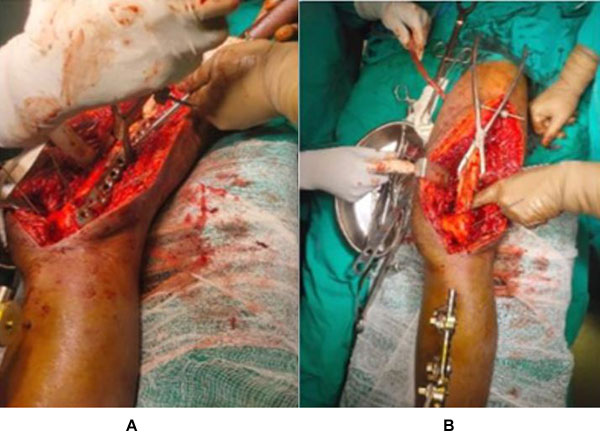A case series on floating knee injuries with ipsilateral femur and tibia fracture
Abstract
Background: The floating injuries occur due to high velocity trauma following motor vehicle accidents. Management of such complex injuries is a challenging task even in experienced hands as there are no standard treatment guidelines. All the patient were first stabilized initially by external fixator and subsequently taken up for definitive surgery. Early fixation and aggressive mobilization ensure fracture union and leads to fewer complications.
Material and method: In this study, 10 cases of fracture ipsilateral femur and tibia were operated in R.D. Gardi Medical College, Ujjain between February 2022 to February 2024 with the sequence of early fixation by application of external fixator on the day of admission, followed by delayed definitive surgery through ORIF with plate osteosynthesis or CRIF with intermedullary nail as needed according to the fracture. This study incorporates all fractures associated with floating knee viz, fracture shaft femur, fracture distal femur (intra/extra articular), fracture proximal tibia with diaphyseal extension and fracture shaft tibia, also includes compound, comminuted fractures.
Results: With the surgical management protocol followed by us, union was achieved in all the 10 cases. Post operative infections was observed in 1 patient out of 10 and knee stiffness was noted in about 3 patients. The present study had a minimum follow up of 6 months.
Conclusion: The surgical management protocol implemented yielded outstanding functional and radiological outcomes across all cases. Patients demonstrated a remarkable ability to resume their pre-injury functional activities and achieved full weight-bearing walking without assistance within six months post-surgery.
Downloads
References
2. Muñoz Vives J, Bel JC, Capel Agundez A, Chana Rodríguez F, Palomo Traver J, Schultz-Larsen M, Tosounidis T. The floating knee: a review on ipsilateral femoral and tibial fractures. EFORT Open Rev. 2017 Mar 13;1(11):375-382. doi: 10.1302/2058-5241.1.000042. PMID: 28461916; PMCID: PMC5367526.
3. Fraser RD, Hunter GA, Waddell JP. Ipsilateral fracture of the femur and tibia. J Bone Jt Surg Br Vol. (1978) 60-b(4):510–5. doi: 10.1302/0301-620X.60B4.711798 CrossRef Full Text | Google Scholar
4. Ran T, Hua X, Zhenyu Z, Yue L, Youhua W, Yi C, et al. Floating knee: a modified Fraser'classification and the results of a series of 28 cases. Injury. (2013) 44(8):1033–42. doi: 10.1016/j.injury.2012.12.012 PubMed Abstract | CrossRef Full Text | Google Scholar
5. Dwyer AJ, Paul R, Mam MK, Kumar A, Gosselin RA. Floating knee injuries: Long-term results of four treatment methods. Int Orthop. 2005;29:314–8.
6. Kumar R. The floating knee injury. J Clin Orthop Trauma. 2011;2:69–76.
7. Kao FC, Tu YK, Hsu KY, Su JY, Yen CY, Chou MC. Floating knee injuries: A high complication rate. Orthopedics. 2010;33:14.
8. Ulfin Rethnam,corresponding author1,4 Rajam S Yesupalan,2 and Rajagopalan Nair3J Trauma Manag Outcomes. 2007; 1: 2,Published online 2007 Nov 26. The floating knee: epidemiology, prognostic indicators & outcome following surgical management Paul GR, Sawka MW, Whitelaw GP. Fracture of the ipsilateral femur and tibia: Emphasis on intraarticular and soft tissue injury. J Orthop Trauma. 1990;4:309–14.
9. Adamson GJ, Wiss DA, Lowery GL, Peters CL. Type II floating knee: Ipsilateral femoral and tibial fractures with intraarticular extension into the knee joint. J Orthop Trauma. 1992;6:333–9.
10. Piétu G, Jacquot F, Féron JM. The floating knee: A retrospective analysis of 172 cases. Rev Chir Orthop Reparatrice Appar Mot. 2007;93:627–34
11. Abalo A, Randolph S, Ayouba G, Walla A, Dossim A. Floating knee: Epidemiology and results of treatment. Niger J Orthop Trauma. 2011;10:23–7.
12. Management of the Floating Knee in Polytrauma Patients - Scientific Figure on ResearchGate. Available from: https://www.researchgate.net/figure/Fig-1-Frasers-classification-of-floatingknee_fig2_281099004 [accessed 25 Apr, 2024


This work is licensed under a Creative Commons Attribution-NonCommercial 4.0 International License.
The entire contents of the Orthopaedic Journal of Madhya Pradesh Chapter are protected under Indian and International copyrights. Orthopaedic Journal of Madhya Pradesh Chapter allow authors to retain the copyrights of their papers without restrictions, Authors grant the publisher the right of exclusive publication. The Journal then grants to all users a free, irrevocable, worldwide, perpetual right of access to, and a license to copy, use, distribute, perform and display the work publicly and to make and distribute derivative works in any digital medium for any reasonable non-commercial purpose, subject to proper attribution of authorship. The journal also grants the right to make numbers of printed copies for their personal non-commercial use under Creative Commons Attribution-Non-commercial share alike 4.0 International Public License.

 OAI - Open Archives Initiative
OAI - Open Archives Initiative












